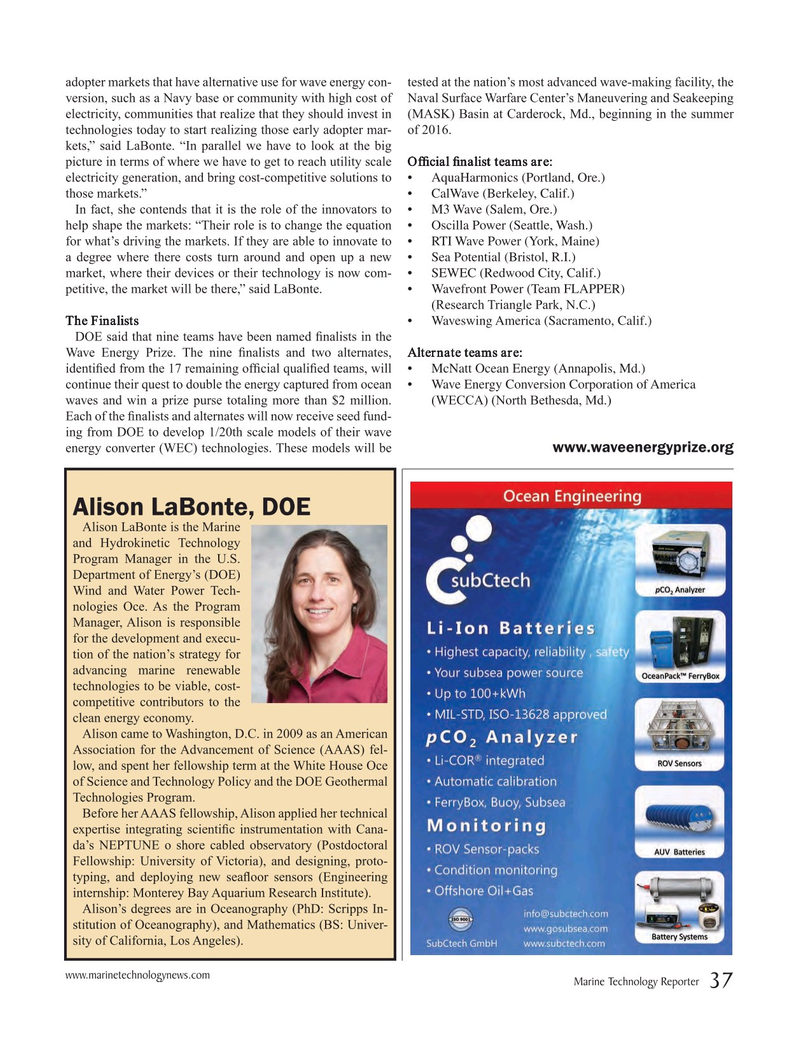
Page 37: of Marine Technology Magazine (April 2016)
Offshore Energy Annual
Read this page in Pdf, Flash or Html5 edition of April 2016 Marine Technology Magazine
adopter markets that have alternative use for wave energy con- tested at the nation’s most advanced wave-making facility, the version, such as a Navy base or community with high cost of Naval Surface Warfare Center’s Maneuvering and Seakeeping electricity, communities that realize that they should invest in (MASK) Basin at Carderock, Md., beginning in the summer technologies today to start realizing those early adopter mar- of 2016.
kets,” said LaBonte. “In parallel we have to look at the big picture in terms of where we have to get to reach utility scale Of? cial ? nalist teams are: electricity generation, and bring cost-competitive solutions to • AquaHarmonics (Portland, Ore.) those markets.” • CalWave (Berkeley, Calif.)
In fact, she contends that it is the role of the innovators to • M3 Wave (Salem, Ore.) help shape the markets: “Their role is to change the equation • Oscilla Power (Seattle, Wash.) for what’s driving the markets. If they are able to innovate to • RTI Wave Power (York, Maine) a degree where there costs turn around and open up a new • Sea Potential (Bristol, R.I.) market, where their devices or their technology is now com- • SEWEC (Redwood City, Calif.) petitive, the market will be there,” said LaBonte. • Wavefront Power (Team FLAPPER) (Research Triangle Park, N.C.)
The Finalists • Waveswing America (Sacramento, Calif.)
DOE said that nine teams have been named ? nalists in the
Wave Energy Prize. The nine ? nalists and two alternates, Alternate teams are: identi? ed from the 17 remaining of? cial quali? ed teams, will • McNatt Ocean Energy (Annapolis, Md.) continue their quest to double the energy captured from ocean • Wave Energy Conversion Corporation of America waves and win a prize purse totaling more than $2 million. (WECCA) (North Bethesda, Md.)
Each of the ? nalists and alternates will now receive seed fund- ing from DOE to develop 1/20th scale models of their wave energy converter (WEC) technologies. These models will be www.waveenergyprize.org
Alison LaBonte, DOE
Alison LaBonte is the Marine and Hydrokinetic Technology
Program Manager in the U.S.
Department of Energy’s (DOE)
Wind and Water Power Tech- nologies Oce. As the Program
Manager, Alison is responsible for the development and execu- tion of the nation’s strategy for advancing marine renewable technologies to be viable, cost- competitive contributors to the clean energy economy.
Alison came to Washington, D.C. in 2009 as an American
Association for the Advancement of Science (AAAS) fel- low, and spent her fellowship term at the White House Oce of Science and Technology Policy and the DOE Geothermal
Technologies Program.
Before her AAAS fellowship, Alison applied her technical expertise integrating scienti? c instrumentation with Cana- da’s NEPTUNE o shore cabled observatory (Postdoctoral
Fellowship: University of Victoria), and designing, proto- typing, and deploying new sea? oor sensors (Engineering internship: Monterey Bay Aquarium Research Institute).
Alison’s degrees are in Oceanography (PhD: Scripps In- stitution of Oceanography), and Mathematics (BS: Univer- sity of California, Los Angeles).
www.marinetechnologynews.com
Marine Technology Reporter 37
MTR #3 (34-49).indd 37 4/4/2016 11:48:40 AM

 36
36

 38
38
